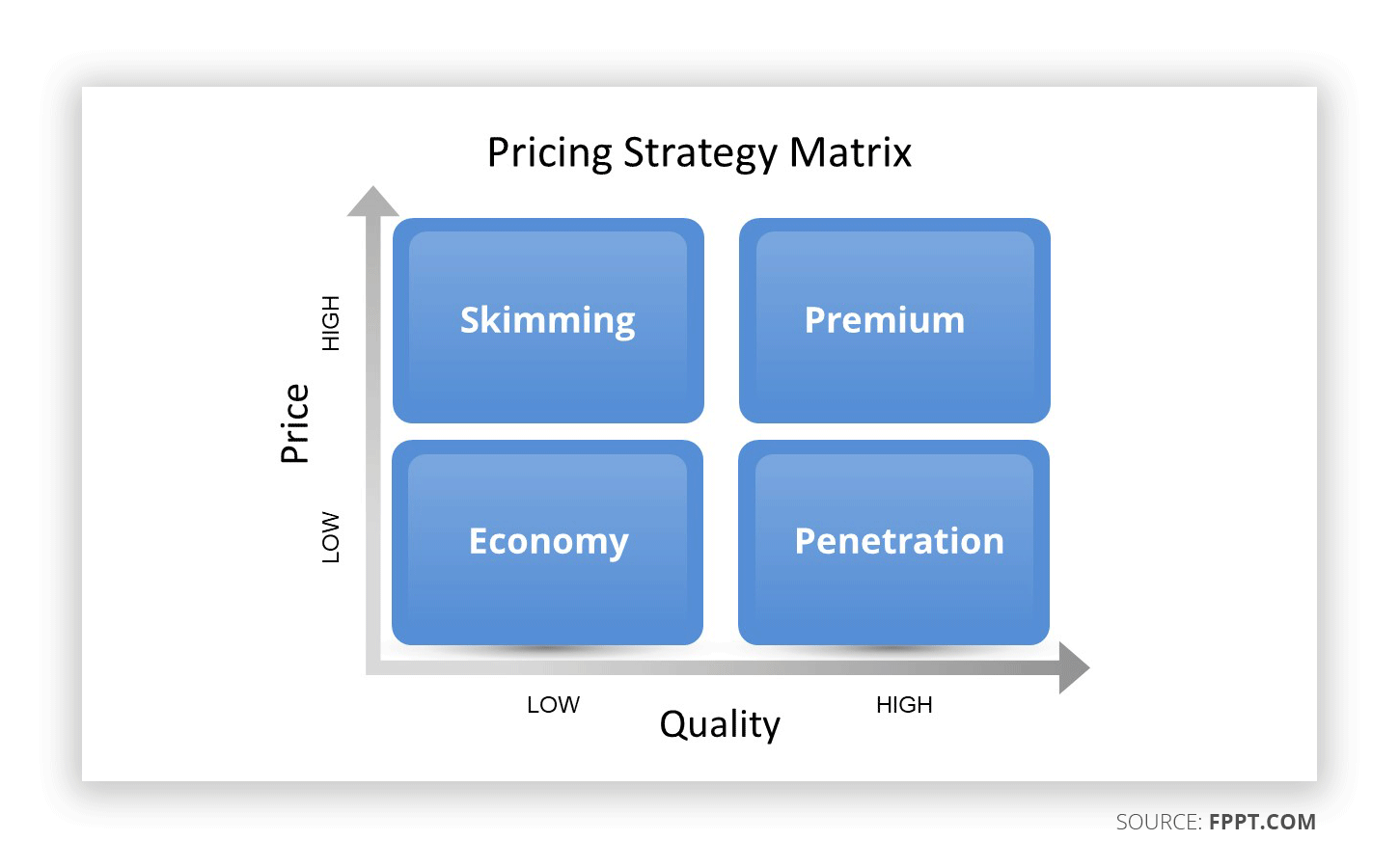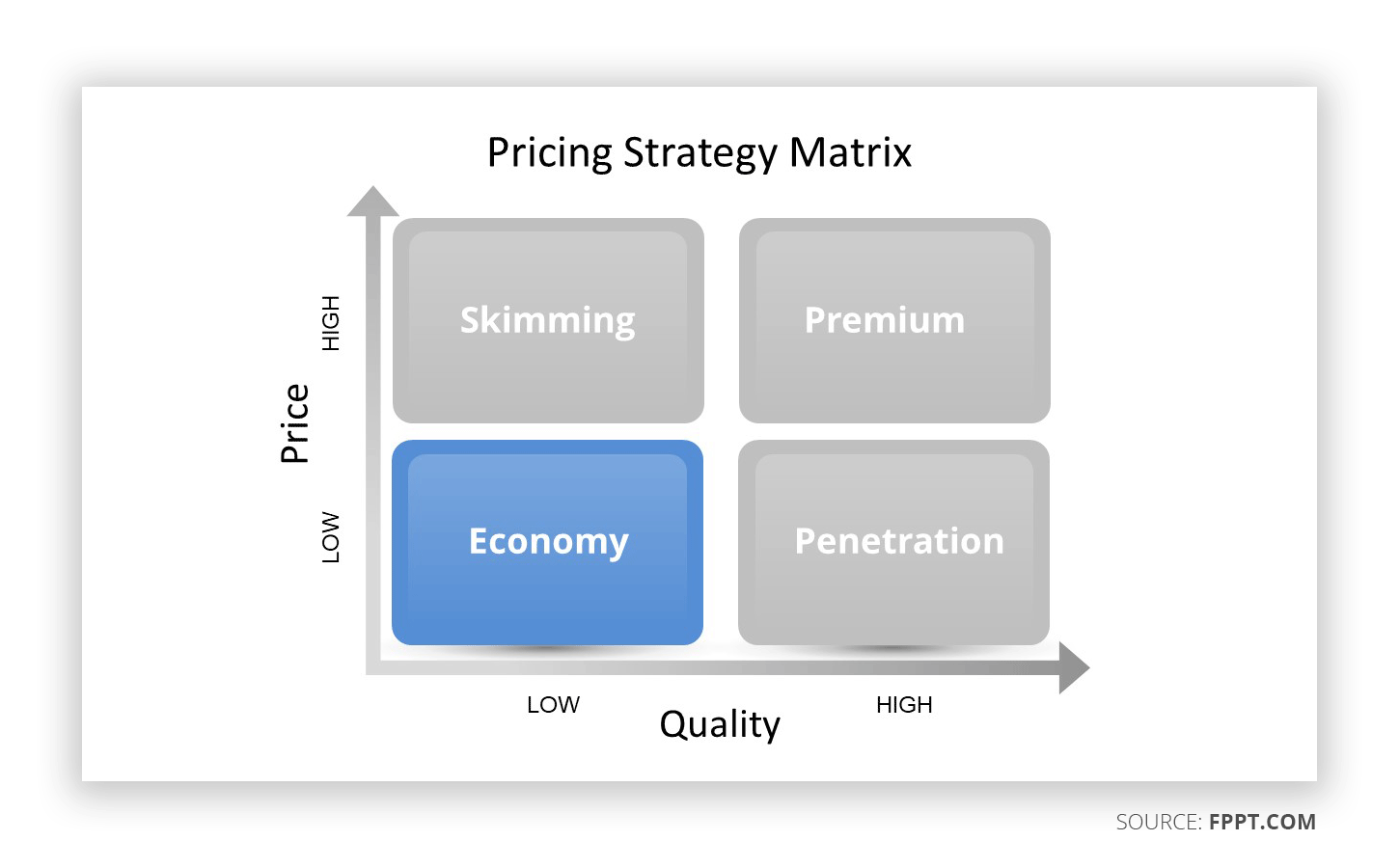How to Set the Right Product Price using Pricing Strategy Matrix
The five Ps of the marketing mix include product, place, price and promotion, with some extending it to seven Ps with the addition of packaging, positioning and people. Among these five or seven Ps there is only one which generates revenue, i.e. ‘price’. Therefore, it is important to ensure that businesses use the right pricing strategy in order to make a business profitable by selling the product at the right price. In this post we will explain how to set the right product price using Pricing Strategy Matrix. At the end of this post you will be able to understand the four commonly used marketing strategies and even be able to explain them in a presentations should you need to.

What is Pricing Strategy Matrix?
Pricing Strategy Matrix is used for determining the appropriate price for a product or service. While price is the only part of the marketing mix which generates revenue; however, it is not the primary consideration when setting a price. The Pricing Strategy Matrix contains different pricing strategies namely, penetration pricing strategy, economy pricing strategy, premium pricing strategy and skimming pricing strategy.
Pricing strategies account for various factors affecting a business such as turnover targets, the features of a product or service, target audience, marketing goals, consumer demand, competitor pricing, market conditions, seasonal changes, etc.
Factors Affecting Pricing Strategies
Determining a price does not simply entail the cost of production. There are many other considerations other than the money spent on producing the product or service.
1. Cost of Production
One of the considerations for determining the price of a product or service is naturally the cost incurred by the business on labour, machinery, rent, marketing, etc.
2. Price Elasticity of Demand
Other than the costs associated with labour, machine, rent and marketing costs, businesses also need to consider what price the customer might be willing to pay for the product.
Inelastic Demand: Some products such as petrol or bread have inelastic demand. This means that people tend to readily buy them even when the price goes up. For such products, the demand remains steady even when price increases. This is because people are unlikely and unable to immediately switch to an alternative fuel for their cars when petrol prices rise or give up on a bread based staple diet.
Elastic Demand: On the contrary, there are products for which the price is said to be elastic, i.e. a change in price results in a major change in demand. For example, while the price for petrol is inelastic, a rise in the price for cars might lead to a decline in sales, as many people might simply opt for public transport or delay upgrading their cars. Similarly, a reduction in the price of cars might lead to increased demand.
Formula for Calculating Price Elasticity: Price elasticity is calculated based on a simple formula:
Price Elasticity of Demand = Percentage change in Quantity Demanded / Percentage Change in Price
Price elasticity is a factor which has a major impact on the way products or services are priced. The elasticity of products or services might differ from country to country, based on consumer demands due to various factors such as staple diet, demand for using certain products or services (e.g. due to seasonal changes), competition, etc.
3. Market Competitiveness
Monopoly suppliers are able to charge a higher price for their product, whereas prices are likely to remain competitive amidst strict competition. There are also variants such as a cartel and oligopoly, while the former is able to influence prices heavily, the latter entails limited competition in the market.
Source: Free Pricing Strategy Matrix PowerPoint template by FPPT.com
Pricing Strategy Matrix: Different Pricing Strategies
There are four different pricing strategies depicted in a Pricing Strategy Matrix. Let’s take a look at all four of these strategies in detail and analyze the pros and cons of using them. These four pricing strategies are the most commonly used by businesses and represent the mapping of price over quality.
Source: Free Pricing Strategy Matrix PowerPoint template by FPPT.com
1. Penetration Pricing Strategy
The bottom right of the Pricing Strategy Matrix shows the penetration pricing strategy. This type of pricing is used to enter a new market or to sell a new product. The penetration price is set low to attract new customers or to lure them away from the competition in the short run.
Example: Consumers might be reluctant to try a new brand of coffee. However, an incredibly low introductory price might tempt people to try the new coffee brand. If they develop a taste for it, this might even lure them away from competitor products.
Advantages of Using Penetration Pricing Strategy: Using a penetration price can help attract new customers, make a new product popular, counter existing competition and can have long-term benefits if the product is able to survive in the market with a reasonable market share.
Disadvantages of Penetration Pricing Strategy: Sometimes, the customer might switch back to the old product once prices are raised again. Consumers might begin to associate the low price with the product, not accepting a higher rate for it. This might be difficult for companies to sustain, considering they might even be selling the product at a loss in the short-term by offering a low price to enter the market. Using penetration price might prompt competitors to resort to predatory pricing to drive out the new competition, leading to a price war. Furthermore, the product even with the low price might struggle due to the stronghold of existing brands.
Recommended reading: Executive Guide to Pricing Strategy Models
2. Price Skimming Strategy
On the top left of the quadrant is price skimming. This is a strategy where the business starts off with a high initial price for a product and then lowers it as demand rises. It is the opposite of penetration pricing. This pricing strategy is often used for luxurious products or services to extract as much revenue in the short run as possible.
Example: An international ice cream chain opens up in a city. The brand is associated with unique ice cream flavours which are novel for the new target audience. People buy the ice cream at high rates for a while, until demand increases and the product also becomes less of a novelty. The ice cream prices are lowered over a period of time.
Advantages of Price Skimming Strategy: There are various advantages of a skimming pricing strategy for businesses these include the ability to quickly recover production costs, increase profit margins, engaging distributors with a high profit incentive and generating a sense of quality among consumers.
Disadvantages of Price Skimming Strategy: Price skimming often leads of low sales volume, might be unsuccessful as a pricing strategy due to prices lowered by competitors and might not be efficient for recovering initial setup and production costs if sales don’t meet expectations. Price skimming might not be suitable for markets where people have a low purchasing power due to poverty or low incomes.
3. Economy or Competitive Pricing Strategy
This pricing strategy looks at the competition instead of the cost of production to set the price. The product’s price might be set below, equal to or above the price of the competition. This strategy is used when a product has been in the market for a while.
Example: A retail store which has established itself in the market and has low overhead costs due to efficiency might choose to undercut the competition with lower costs.
Advantages of Economy Pricing Strategy: Using economy pricing can be a good way of countering competition and cementing an already established position in the market.
Disadvantages of Economy Pricing Strategy: Smaller businesses might not be able to benefit from such an approach. Customer loyalty might be impacted if better prices are available elsewhere, e.g. if the business tries to charge a higher price than the competitor.
4. Premium Pricing Strategy
Some products or services are priced high as they are considered premium. Lowering the price can have negative consequences, making the product appear as low quality. Premium pricing strategy aims to maintain that consumer perception by charging high prices.
Example: A seven-star hotel chain keeps prices high, as it is deemed premium and consists of a small, affluent clientele. Lowering the price would result in the service appearing as low quality and will no longer be considered ‘premium’. Many brands such as Hyatt Hotels or Burj Al Arab in Dubai, UAE are associated with luxury and premium pricing. Similarly, Rolex, Louis Vuitton and Chanel are all examples of businesses using premium pricing.
Advantages of Premium Pricing Strategy: Such a strategy can lead to extravagant profits, a positive brand image and attract aspirational buyers.
Disadvantages of Premium Pricing Strategy
Products with premium pricing are hard to initiate and maintain, producing too much of the product can raise costs, whereas a reduction in production can lead to shortages. Selling such a product can also be hard in tough economic conditions, leading to bankruptcy or closure. Such products are easily undercut with low price rivals and the purchasing power of people for such products is likely to be low not only in a specific market but also on a global scale. In times of Covid-19 and lockdowns, many premium businesses are operating at a loss, trying to stay afloat while others have either shut down or are nearing closure, as they fail to sell their overpriced products.
Marketing Mix and Pricing Strategies
The video below provides a detailed overview of pricing strategies and the marketing mix.
Conclusion
How a business uses a pricing strategy will depend upon various factors, be it consumer demand, cost of production, the scope for expansion, purchasing power of the target audience, as well as other factors of the product mix such as product, place, promotion, packaging, positioning and people. Setting a price entails a complex process, with careful considerations before, in-between and after the launch of a product. The four pricing strategies of the Pricing Strategy matrix serve as a good method for analyzing the right pricing strategy, based on considerations related to quality and price of the product.
We will send you our curated collections to your email weekly. No spam, promise!


